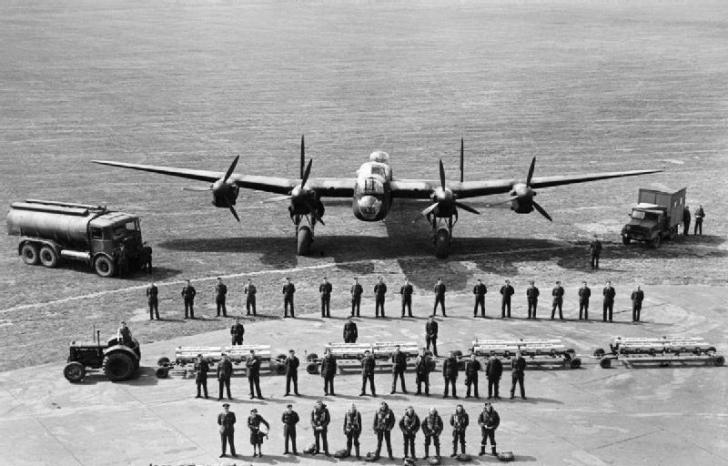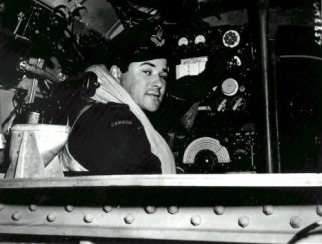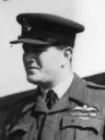Ground Crew Personnel
The Extensive Team Required to Keep a Lancaster Fully Operational
Top Left, Petrol Bowser & Crew.
Top Right, Mobile Workshop & Crew.
2nd Row down, Corporal Mechanic, 4 Aircraftsmen (Mechanics), Engineer Officer, Fitter (Armourer), 3 Armourers, Radio Mechanic, 2 Instrument Repairers, 3 Bomb Handlers, Fitter.
3rd Row from bottom: Bomb Train with WAAF Driver & Bombing-up Crew.
2nd Row from bottom: Flight Maintenance Crew, from left as follows: NCO Fitter, Mechanic, NCO Fitter, 5 Mechanics, Electrical Mechanic, Instrument Repairer, 2 Radio Mechanics
Bottom Row, from left: Flying Control Officer, WAAF Parachute Packer, Meteorological Officer Aircrew: Pilot, Navigator, Air Bomber, Flight Engineer, Wireless Operator/Air Gunner, 2 Air Gunners
Of the 2500 Personnel which were housed on a Wartime Bomber Command Airfield, only 10% were Aircrew. Dozens of others were required to prepare each Lancaster for Flight and the Ground Crew were most appreciated by the Aircrew. Generally working Outside, the conditions, especially in the Winter, were often windswept, wet & cold. Their contributions to the successes of the effort cannot be overemphasised. The Ground Crew which were associated with each Aircraft took immense pride in “their” Aircraft and would joke that they were only “loaning” the Bomber for a few hours and that the Aircrew were “not to break it.”

Fuselage Interior

Inside the Lancaster, looking forward towards the Cockpit. The 3 round windows towards the bottom of the picture look into the Bomb Bay, and were there to enable to Crew to check that all the Bombs had been released.
At the beginning of the War “Wireless-Air Gunners” (WAG’s) played a Dual Role, being responsible for Radio Operations as well as the Operation of the Gun Turret. Later, with the Advent of the 4-Engined Bombers with 7 Crew Members, this Combined Role was no longer necessary.
– Search Sky before Take-off & Landing, your Aircraft is most vulnerable.
– If Gun-fire, search for Fighter; take Evasive Action.
– Always watch your own Tail.
– Conserve your Ammo; if you’re Fired upon from Long Range, instruct Pilot to use Evasive Action.
– Never Fly Straight or Dive when under Attack.
– Use good Teamwork with rest of Crew.
– Patrol across the Sun, never into or away from it.
– Never turn away from an Attack, always Towards.
– If using Tracer at night, remember it tends to momentarily destroy your Night Vision; hold your Fire until necessary.
– If on Reconnaissance Aircraft; your job is to return with Information; not to seek Combat with Enemy Aircraft.
– The Aim of Enemy Fighter is to Destroy; the Aim of a Bomber Air Gunner is to get safely to Target & Back to Base.
– Never Fire until Fired upon.
– All Aircraft approaches are considered to be Enemy until identified otherwise.
– Remember: To Be Surprised is to be Lost.
– If your own Guns Fail or are Damaged during an Attack use your ingenuity to Outwit the Attacker.
At Night Jerry has a big bag of tricks for Decoys. He sends one Aircraft along your Course with Identification Lights on. He sends one behind you on your Tail; or has one come out of the Moon. On any of these be sure and search on the opposite side of your Aircraft for the real Attacker. His favourite position, if he can get it, is to come from Below & Climb up to 300yds from you, directly underneath, stall his Aircraft and Rake your Fuselage with Machine-Gun & Cannon Fire. Invariably the Bombs Explode and the Bomber disintegrates. So every now and then have your Pilot do steep turns so you can search below the Aircraft for Fighters. Searchlights co-operate with the Fighters in many different ways. Sometimes they send a series of dots in your direction. Sometimes they wave along your Course. Sometimes they search for you & Cone you. If this happens and they suddenly go off, then you know a Fighter has found you. If there is a Cloud cover below, the Searchlights light up the Clouds and you are silhouetted for the Fighter above you.
Flak – Anti-Aircraft Fire. From the German, “FlugAbwehrKanonen‘. In reports “Heavy Flak” did not refer to the Concentration or Degree of Flak but to the Calibre observed. “Heavy Flak” referred to anything of 88mm and higher; while “Light Flak” consisted of Quick Firing 20, 30 or 40mm Guns. By extension, Flak came to mean any grief given to you by anyone else.

Lancaster Interior
A look inside the Lancaster to give you some idea of the duties and conditions under which the Aircrew work. Starting at the Entrance Door immediately inside the Fuselage there is a Flare Chute. This carries a high-velocity Flare that is dropped at the same time as the Bombs to Photograph and record the Bomb Strike. To the left are 2 stowage’s one for the Rear Gunners Parachute and one for a portable oxygen bottle. We then see into the Gun Turret to the Rear. Above the Entrance Door is Stowage for the Entrance Ladder. It was the Duty of the Engineer to see that the Ladder was in the Stowage and the door Locked and so inform the Pilot. Close by the door to the front is suspended a Remote Recording Compass positioned here away from all Radio & Electrical Interference; the Readings were shown on Instruments in the Pilots and Navigators Positions.

 Going forward up the Fuselage you pass under the Mid-Upper Gun Turret On the Port side is a Rest Bed for use if a Crew member is injured. Underneath it are 16 oxygen bottles for the supply to the Crew at altitude. In the Air the Engineer would monitor the supply to each Crew member from his position. Then there is the main spar of the Aircraft with parts of the Hydraulics & Compressed Air Systems attached. Note the small gap to get through to get to the Front Cockpit. Immediately after the Spar on the Port side is the Wireless Operator
Going forward up the Fuselage you pass under the Mid-Upper Gun Turret On the Port side is a Rest Bed for use if a Crew member is injured. Underneath it are 16 oxygen bottles for the supply to the Crew at altitude. In the Air the Engineer would monitor the supply to each Crew member from his position. Then there is the main spar of the Aircraft with parts of the Hydraulics & Compressed Air Systems attached. Note the small gap to get through to get to the Front Cockpit. Immediately after the Spar on the Port side is the Wireless Operator
To use the term working conditions in the context of War is of course horribly inappropriate. The conditions under which a Bomber Crew had to operate were Spartan. A WW2 Bomber was not an Airtight creation. Exhaust Fumes from the Engines would leak in and induce passivity. Some Airmen used a stimulant Agent called Benzedrine to cope. The Operational Altitude of the Aircraft was cold all year round. So Heat from the Engines was led into the Cockpit, where it then reached the Pilot, Flight Engineer, Navigator & Radio Operator. In the Navigators Station, it was often too hot. The Bomb Aimer in the front of the Plane, where he also acted as Gunner, had a cold position. The Mid-Turret Gunner, and above all, the Tail Gunner were very exposed to the Freezing conditions. In the Flight Overalls, there were Heating Coils which Airmen could connect via Cables & Connectors. The need for this is easy to understand when the temperature could drop to below -40°C. The ability to move around on board was limited because the level of Vigilance must be on top during the entire Mission. The longest Missions, such as Königsberg, could be nearly 12-hrs duration. This said a Raid on Stettin (Now in Poland) took about 9-hrs. There was a single Toilet bucket on board, but who wanted to undress their protective Suits and go to the Toilet in the extreme cold? Therefore many avoided drinking enough water which in turn resulted in Dehydration & Medical complications.
 Most Aircrew in a Lancaster would not wear a Parachute during Flight. They were not comfortable to sit on and obstructed movement in tight Locations. For the same reason, they wore no Life Jacket when they flew over the Land. To save yourself by Baling Out from a doomed Lancaster was not an easy task. Especially when the Aircraft was spinning or flew upside down. If the Aircraft flew level the Tail Gunner could, after putting on his Parachute which was stowed in the Fuselage would rotate the Tower so that he sat with his back to the Open Door of the Turret and then simply fall out backwards. The Mid Turret Gunner & Wireless Operator used the Main Hatch on the Starboard Side while the Rest of the Crew (Bomb Aimer, Pilot, Flight Engineer and Navigator) used the Emergency Exit in the Floor of the Bomb Aimer’s Station. When leaving through the Main Hatch the Crew had to watch out not to hit the Tail Stabiliser. The Order in which the Crew would Bale Out could change due to Structural damage or Fire on board.
Most Aircrew in a Lancaster would not wear a Parachute during Flight. They were not comfortable to sit on and obstructed movement in tight Locations. For the same reason, they wore no Life Jacket when they flew over the Land. To save yourself by Baling Out from a doomed Lancaster was not an easy task. Especially when the Aircraft was spinning or flew upside down. If the Aircraft flew level the Tail Gunner could, after putting on his Parachute which was stowed in the Fuselage would rotate the Tower so that he sat with his back to the Open Door of the Turret and then simply fall out backwards. The Mid Turret Gunner & Wireless Operator used the Main Hatch on the Starboard Side while the Rest of the Crew (Bomb Aimer, Pilot, Flight Engineer and Navigator) used the Emergency Exit in the Floor of the Bomb Aimer’s Station. When leaving through the Main Hatch the Crew had to watch out not to hit the Tail Stabiliser. The Order in which the Crew would Bale Out could change due to Structural damage or Fire on board.
To serve in the Air Force was made to look glamorous in the Recruitment Adverts. The reality was quite different. One advantage was that after the Missions you could eat decent food, have the opportunity to Shower & Sleep in a Bed with clean sheets. If there was no Mission one Night you could go to the Pub and meet the Girls both Local & WAAF’s.
Dramatic Portrait of a Typical Flight
http://www.telegraph.co.uk/telegraphtv/3272415/A-guided-tour-of-a-Lancaster-Bomber.html
